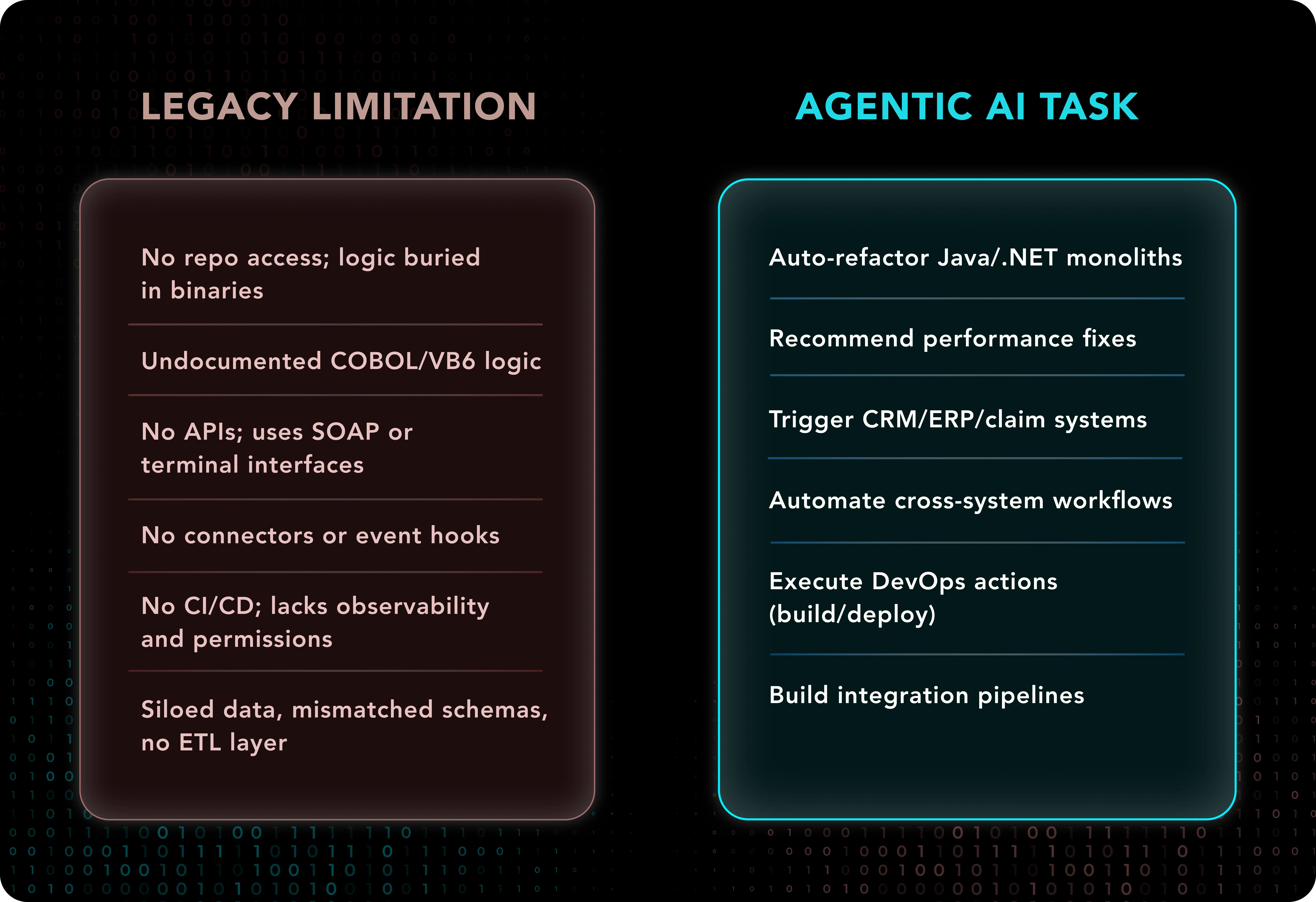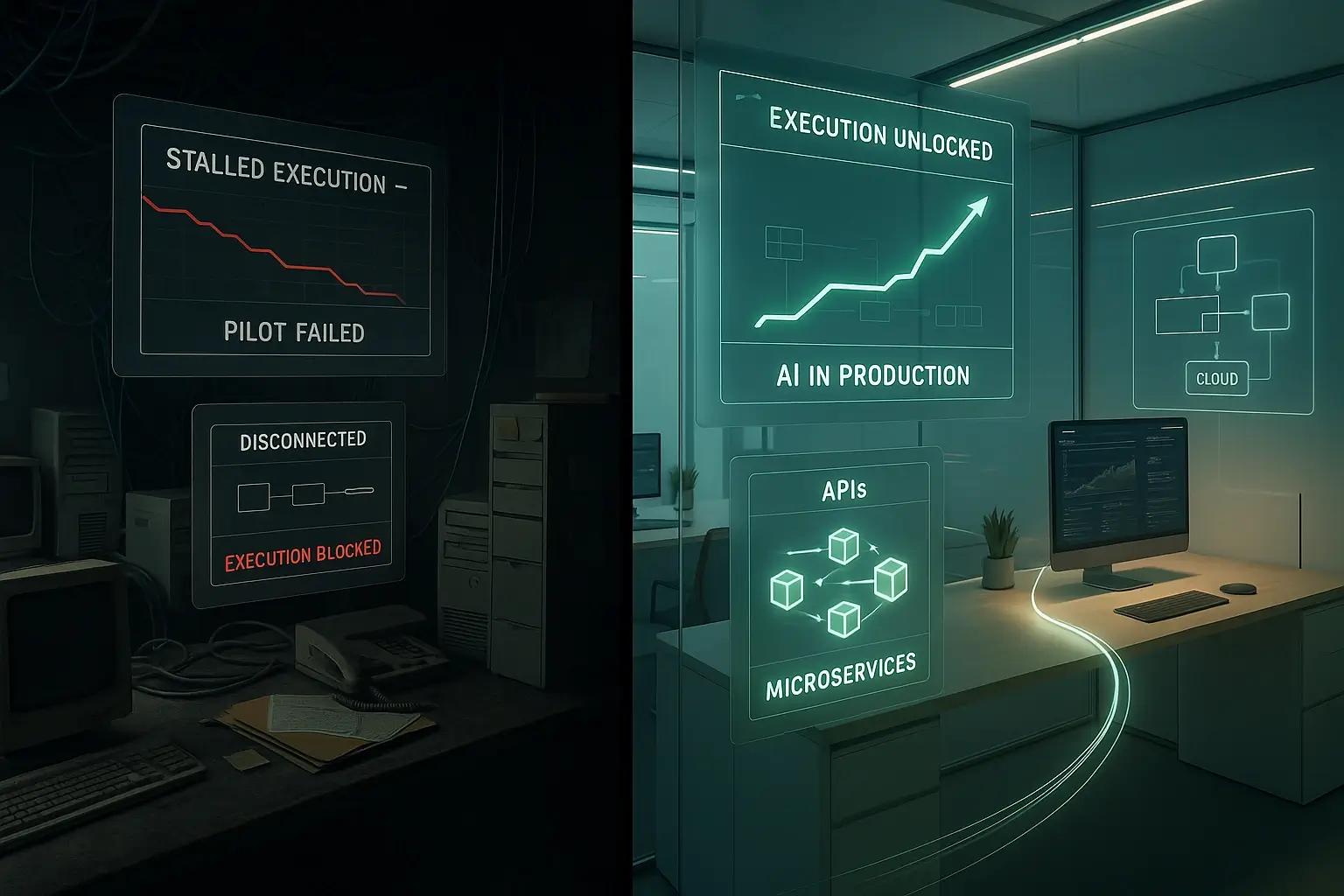70% of Your IT Budget Is Wasted on Legacy
Legacy systems drain your spend, slow your teams, and stall innovation. Modernize with speed, security and confidence — guided by our experts.
In June 2025, Gartner reported a wake-up call : Over 40% of agentic AI projects will be abandoned by 2027 not due to flaws in AI itself but because enterprises are forcing modern autonomy onto decades-old systems.
S&P Global Market Intelligence echoed this, revealing that 42% of AI initiatives failed in 2025, up from 17% in 2024. The primary culprit? Legacy complexity.
These are not theoretical struggles.
They appear as delayed rollouts, unstable integrations, poor code quality and inflexible infrastructure. Legacy systems, built for static workflows, simply can’t keep pace with the dynamic demands of agentic AI—resulting in a widening gap between strategic ambition and real-world execution.
In 2025, the challenge isn’t the AI itself, but the outdated environment it’s forced to operate in. To move beyond pilots, enterprises must modernize their legacy foundations so agentic AI can reach its full potential.
What Agentic AI Promises And Why It Breaks Inside Legacy Environments
Let’s talk about what Agentic AI is really built for and why it struggles (and often stalls) when thrown into enterprise stacks built in the 90s or early 2000s.
Agentic AI goes beyond traditional LLMs—it combines reasoning, orchestration, tool use and memory into a unified autonomous execution layer. It’s built to think, plan, and act independently in iterative cycles.
At its best, Agentic AI acts as an autonomous teammate, capable of going beyond co-pilot to become a hands-on operator.
This appears to be precisely what today’s enterprises require. A tireless teammate who understands context, connects dots and acts intelligently without being micromanaged.
But here is the brutal reality: What Enterprises Expect vs. What Actually Happens — a widening gap that stalls innovation before it even begins
It all sounds promising—until strategy meets reality. Agentic AI is built for enterprise scale, but the moment it tries to interact with legacy systems, it stalls at the starting line.

You might be nodding along, thinking:
"That’s exactly what happened to us. We ran the pilot. The AI worked great in staging but once it connected to the core systems, it failed”.
So why exactly are these agentic AI deployments failing?
Let’s not sugarcoat this: Legacy systems weren’t designed for autonomous execution.
A recent report showed that agentic AI agents succeed in only 35% of multiturn tasks, though single-turn tasks fare better at around 58%—a clear signal that sustained, autonomous execution in real-world systems still faces major friction.
Real Architectural Mismatches That Block Agentic AI
AI agents work brilliantly—until backend integration becomes the bottleneck, proving that the real challenge isn’t intelligence, but seamless connectivity.
Many enterprises are deploying agentic AI without realizing that poor legacy system integration is the root cause of execution failures. Here is what most don’t realize until pilots stall: Here is what most don’t realize until pilots stall:
No Real-Time Execution Surface→
Legacy platforms like AS/400, IBM z14, or SAP ECC operate in batch cycles, with no real-time triggers, event listeners or execution endpoints—leaving AI agents unable to act, only observe.
Obsolete or Inaccessible Interfaces→
Agentic AI needs REST APIs, SDKs, or secure pipelines. But legacy systems? Think SOAP/XML buried behind firewall rules or local-only access. Zero connectivity.
Coupled Logic and Tribal Knowledge→
Decades-old systems embed business logic in hardcoded scripts, undocumented modules, poor code quality and brittle dependencies. Without modular design or traceable rules, AI can’t reason through or safely modify workflows.
Legacy Identity and Authentication Gaps→
Agentic AI requires secure, automated access. Yet many systems rely on static credentials, LDAP-only auth or manual logins—making integration a compliance risk in the absence of federated identity or modern IAM.
Governance Bottlenecks→
Even small changes to legacy code can trigger weeks of CAB reviews, regression testing, and downtime windows. This operational friction makes agile iteration and agent-driven workflows virtually impossible.
Making Agentic AI Work in Legacy Enterprises—Without Rebuilding Everything

Enterprises with decades-old infrastructure aren’t excluded from the agentic AI shift—they just need a smarter path: selective, execution-ready modernization that lets AI act, not just think.
1. Audit Your Stack for Execution Barriers
Forget “data readiness.” Start with execution readiness. According to Gartner 85% of failed AI pilots happened in environments without real-time access.
Segment your stack by:
- What AI can execute
- What AI can observe
- Where AI is completely blocked
That’s your starting point for modernization.
2. Start Modular—Don’t Go Enterprise-Wide on Day One
Avoid the trap of top-down, enterprise-wide rollouts.
Choose modular domains—like internal ops, logistics or claims—that already have automation or modern APIs.
These become:
- Safe zones to test value delivery
- Proof points for enterprise-wide buy-in
3. Adopt Multi-Agent Orchestration Where Ready
Agentic AI doesn’t demand full autonomy upfront. Enterprises can introduce modular orchestration that mimics agent workflows—breaking down processes into trackable, loosely coupled tasks. This prepares infrastructure for agent-based execution as modernization progresses, without disrupting existing operations.
4. Modernize with Agentic Execution in Mind
Carefully planned legacy application modernization strategies are critical for enterprises aiming to enable AI to act with precision, speed, and business relevance.
Focus on:
- Component-based refactoring
- Secure, federated identity
- Real-time observability
- Composable services
This is how you enable execution-ready AI modernization. Traditional strategies fall short by merely masking legacy systems. Platforms like AppMod.AI enable true transformation—laying a future-proof foundation where Agentic AI can execute, not just observe.
Modernize Now or Watch Millions Burn in Failed Pilots
Agentic AI isn’t failing because it’s too advanced.It’s failing because enterprise systems are too outdated to support it.
The leading enterprises see this clearly. They’re modernizing with precision and deploying AI with C.A.R.E—because in brittle environments, innovation without safeguards becomes a risk, not a strategy.
When compliance is on the line, “move fast and break things” no longer applies.
That’s where AppMod.AI ensures Agentic AI doesn’t get stuck in theory. We enable Fortune 500s to deploy AI at scale—4× faster and at one-third the cost—with zero disruption to existing operations.
The choice is clear: Modernize with intent or watch your AI strategy collapse under legacy weight.
Will Your Agentic AI Become Another Million-Dollar Failure?
Legacy architecture is blocking Agentic AI execution, scalability and ROI. Every stalled agent is a hidden cost center draining value. Don’t let outdated systems silently kill your AI investments.
Blog Summary
Over 40% of Agentic AI projects are expected to fail by 2027 not due to AI limitations, but because they’re deployed on legacy systems built for static workflows. The root issue is architectural: Agentic AI requires real-time execution, modular design, and modern APIs—capabilities legacy infrastructure lacks. Instead of large-scale overhauls, success lies in targeted modernization where AI can truly operate. Platforms like AppMod.AI make this possible—helping organizations modernize with precision and deploy AI 4× faster at significantly lower cost.




